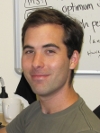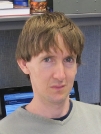Visitors at NIMBioS in 2011
Short-term visitors to NIMBioS are supported for periods up to one week to assist their efforts in carrying out research that conforms to the mission of NIMBioS to foster research at the interface between mathematics and biology.
Visitor/Sabbatical Archive
 Eti Wiraningsih (Mathematics, Jakarta State Univ.)
Eti Wiraningsih (Mathematics, Jakarta State Univ.)
Project Title: Rabies Model between dogs and human: Stability analysis and optimal control problem
Eti Wiraningsih is collaborating with
Suzanne Lenhart (UTK/NIMBioS)
and Folashade Agusto (Austin Peay University)
to develop a rabies model.
A system of differential equations modelling rabies in dogs and humans in Indonesia was refined. Stability analysis for this system was completed to
study the effects of parameters on the long term behavior. Optimal control was used as a tool to investigate management strategies for vaccination in dogs. The model was extended to include wild dogs and domestic dogs and work on the corresponding stability analysis was started. In the future, further management strategies including vaccination of humans will be considered. Optimal control of the extended model will be treated.
Wiraningsih also participated in the NIMBioS Investigative Workshop on Modeling Feral Cats and Rabies, Nov. 9-11.
Visit Dates: Nov. 3-17, 2011
Report
 Mateusz Plucinski (Environmental Science, Policy, & Management, UC Berkeley)
Mateusz Plucinski (Environmental Science, Policy, & Management, UC Berkeley)
Project Title: Ecological models to study the interaction of infectious disease and income
Mateusz Plucinski is collaborating with Calistus Ngonghala on modeling the interaction of infectious disease and sociological factors.
Visit Dates: Oct. 16 - 29, 2011
 Yasuhiro Suzuki (Microbiology, Immunology & Molecular Genetics, Univ. Kentucky College of Medicine)
Yasuhiro Suzuki (Microbiology, Immunology & Molecular Genetics, Univ. Kentucky College of Medicine)
Project Title: Modeling of host-pathogen interactions in infection with Toxoplasma gondii
Yasuhiro Suzuki, pictured far left, is collaborating with UT professors
Michael Gilchrist,
not pictured, and
Xiaopeng Zhao,
center, to develop a mathematical model of the immune response control of T. gondii. NIMBioS graduate research assistant Adam Sullivan is pictured far right.
Visit Dates: October 20-21, 2011
 Michael Bode (Botany, Univ. of Melbourne)
Michael Bode (Botany, Univ. of Melbourne)
Project Title: Optimal scale of conservation organizations
Michael Bode is collaborating with Paul Armsworth to investigate optimal scale of biodiversity conservation nonprofit organizations.
Visit Dates: Aug. 29 - Sept. 18, 2011
NIMBioS video: Preserving Nature on Land and Sea
 Ben Rosenthal (Animal Parasitic Disease Lab, USDA)
Ben Rosenthal (Animal Parasitic Disease Lab, USDA)
Project Title: Transmission dynamics and optimal control of T. gondii
Ben Rosenthal is collaborating with Suzanne Lenhart and
Xiaopeng Zhao
to develop a mathematical model of the T. gondii transmission cycle and design optimal control strategies to suppress the disease.
Visit Dates: Sept. 6-7, 2011
 Irina Nikitina
(Central Tuberculosis Research Institute, Moscow)
Irina Nikitina
(Central Tuberculosis Research Institute, Moscow)
Project Title: Mathematical modeling of CD4 T-cell differentiation during a chronic infection
Irina Nikitina collaborated with Vitaly Ganusov (Microbiology, Univ. of Tennessee), pictured right, to model T-cell differentiation during chronic pulmonary tuberculosis infection in humans. The effects of tuberculosis activity on T-cell differentiation was investigated under different scenarios of disease, including chronic and new cases. Analysis revealed that tuberculosis severity and destruction processes in lungs are the main factors explaining the differentiation status of TB-specific T-cells. The next step involves creating the mathematical model of T-cell differentiation during TB infection. The work should be completed later in 2011, and a paper will be submitted to a immunological and/or mathematical biology journal.
Visit Dates: August 15 - September 7, 2011
Products
Publication: Nikitina IY, Kondratuk NA, Kosmiadi GA, Amansahedov RB, Vasilyeva IA, Ganusov VV, Lyadova IV. 2012. Mtb-specific CD27low CD4 T cells as markers of lung tissue destruction during pulmonary tuberculosis in humans. PLoS ONE, 7(8): e43733. [Online]
 Mike Sanderson (Diagnostic Medicine & Pathobiology, College of Vet. Medicine, Kansas State Univ.)
Mike Sanderson (Diagnostic Medicine & Pathobiology, College of Vet. Medicine, Kansas State Univ.)
Project Title: Ecological modeling of E. coli O157 in beef feedlots
Mike Sanderson is collaborating with
Cristina Lanzas to model E. coli O157 shedding at individual and beef feedlot scales.
Visit Dates: July 25-29, 2011
Products
Publication: Chen S, Sanderson MW, White BJ, Amrine DE, Lanzas C. 2013. Temporal-spatial heterogeneity in animal-environment contact: Implications for the exposure and transmission of pathogens. Scientific Reports, 3: 3112. [Online]
Publication: Chen S, Sanderson M, Lanzas C. 2013. Investigating effects of between- and within-host variability on Escherichia coil 0157 shedding pattern and transmission. Preventive Veterinary Medicine, 109(1-2): 47-57. [Online]
Presentation: Chen S, Sanderson M, White B, Amrine D, Lanzas C. 20-23 May 2013. Poster: Temporal-spatial heterogeneity in animal-environment contact: Implications for the exposure and transmission of pathogens. Ecology and Evolution of Infectious Disease, State College, PA.
 Joseph C. Watkins (Mathematics, Univ. of Arizona)
Joseph C. Watkins (Mathematics, Univ. of Arizona)
Project Title: Discussion of NiMBioS/HHMI Biomath Consortium Cooperation
The HHMI Biomath Consortium members at the Univ. of Delaware, Emory Univ. and the Univ. of Arizona are hosting conferences of researchers and educators to advance the issues of quantitative training of life science undergraduate students. Because this activity has significant overlap with the NIMBioS mission, a meeting with the conference host — Univ. of Arizona — for the June 2012 meeting, "Making Biomath Happen," and members of the NIMBioS leadership is intended to improve collaboration.
Visit Dates: July 14-15, 2011

Rana Parshad
(Institute for Computing and Math Engineering, Stanford Univ.)
Project Title: Optimal control analysis of a system of reaction diffusion equations modeling the spread of Aedes aegypti mosquitoes by the sterile insect technique and insecticide
Rana Parshad (pictured left) is collaborating with Suzanne Lenhart (middle), Fola Agusto (right) and Sharon Bewick (not pictured) to perform simulations modeling the spread of mosquitoes with different control techniques.
Visit Dates: July 1-5, 2011
Products
Publication: Agusto FB, Bewick S, Parshad RD. 2012. Mosquito management in the face of natural selection. Mathematical Biosciences, 239(1): 154-168. [Online].

|
| (From left) A. Presotto, C. Collins, M. Madden, R. Salinas, J. Corn (not pictured, L. Holmstrom) |
Feral Hog Visiting Group
Project Title: Modeling Feral Swine
Joe Corn
(Wildlife Disease Study, Univ. of Georgia College of Veterinary Medicine),
Lindsey Holmstrom
(Epidemiology, UC Davis),
Marguerite Madden
(Geography, Univ. of Georgia), and
René Salinas
(Mathematical Sciences, Appalachian State Univ.) were short-term visitors to NIMBioS, joined by Eric Carr (NIMBioS), Charles Collins (Mathematics, Univ. of Tennessee), Graham Hickling (Univ. of Tennessee/NIMBioS), Suzanne Lenhart (Univ. of Tennessee/NIMBioS), Agricola Odoi (Univ. of Tennessee/NIMBioS), Andrea Presotto (Geography, Univ. of Georgia), and Bill Stiver (Great Smoky Mountains National Park). The group met to discuss feral swine models.
Visit Dates: May 23-24, 2011
 Mae Woods (Mathematics, Univ. College London)
Mae Woods (Mathematics, Univ. College London)
Project Title: Modeling collective cell migration of neural crest cells in Xenopus laevis
Woods (pictured right) is collaborating with NIMBioS sabbatical fellow Karen Page (left) to advance the neural crest cell migration effort.
Visit Dates: May 14-22, 2011
Products
Publication: Woods ML, Carmona-Fontaine C, Barnes CP, Couzin ID, Mayor R, Page KM. 2014. Directional collective cell migration emerges as a property of cell interactions. PloS ONE, 9(9): e104969. [Online]
Publication: Carmona-Fontaine C, Theveneau E, Tzekou A, Tada M, Woods M, Page KM, Parsons M, Lambris JD, Mayor R. 2011. Complement fragment C3a controls mutual cell attraction during collective cell migration. Developmental Cell 21(6): 1026-1037. [Online].
 Hem Raj Joshi (Mathematics, Xavier Univ.) and
Sanjukta Hota (Mathematics, Fisk Univ.)
Hem Raj Joshi (Mathematics, Xavier Univ.) and
Sanjukta Hota (Mathematics, Fisk Univ.)
Project Title: Optimal control of SIR model
Joshi (pictured) and Hota (see Short Term Visitors 2010) are collaborating with Suzanne Lenhart (NIMBioS/UTK) to develop an optimal control model investigating the effect of education on HIV control.
Visit Dates: May 18-20, 2011
 Daniel Maxin (Mathematics, Valparaiso Univ.) and Ludek Berec (Theoretical ecology, Biology Centre ASCR, Institute of Entomology, Ceske Budejovice, Czech Republic)
Daniel Maxin (Mathematics, Valparaiso Univ.) and Ludek Berec (Theoretical ecology, Biology Centre ASCR, Institute of Entomology, Ceske Budejovice, Czech Republic)
Project Title: Applying two-sex population models to epidemiological problems
Maxin (left) and Berec are collaborating on a project to apply two-sex population models to epidemiological problems.
Visit Dates: April 9-16, 2011
Products
Publication: Berec L, Maxin D. 2014. Why have parasites promoting mating success been observed so rarely? Journal of Theoretical Biology, 342: 47-61. [Online]
Publication: Berec L, Maxin D. 2013. Why have parasites promoting mating success been observed so rarely? Journal of Theoretical Biology. [Online]
Publication: Berec L, Maxin D. 2012. Fatal or harmless: Extreme bistability induced by sterilizing, sexually transmitted pathogens. Bulletin of Mathematical Biology. Published online 5 January 2013. DOI 10.1007/s11538-012-9802-5. [Online]
 Kevin Flores (Mathematics, Arizona State Univ.)
Kevin Flores (Mathematics, Arizona State Univ.)
Project Title: An individual-based model for the evolution of eusociality via maternal manipulation
Kevin Flores (left) is collaborating with NIMBioS GRA Mauricio Gonzalez-Forero to develop an individual-based model for the evolution of eusociality via maternal manipulation.
Visit Dates: April 11-15, 2011
 Ryan Chisholm (Smithsonian Tropical Research Institute)
Ryan Chisholm (Smithsonian Tropical Research Institute)
Project Title: Analyzing biodiversity patterns in theoretical community models with variable niche structure
Ryan Chisholm is collaborating with NIMBioS postdocs Erol Akçay, Sharon Bewick and Will Godsoe to investigate biodiversity patterns in community ecology.
Visit Dates: Apr. 2-10, 2011
 Urmi Ghosh-Dastidar
(Mathematics, New York City College of Technology, CUNY).
Urmi Ghosh-Dastidar
(Mathematics, New York City College of Technology, CUNY).
Project Title: Study and analysis of aquatic pathogenic transmission
Urmi Ghosh-Dastidar collaborated with Suzanne Lenhart to research optimal vaccination strategies in an epidemic model of cholera. The effect of seasonality in pathogen transmission on vaccination strategies was investigated under several types of disease scenarios, including an endemic case and a new outbreak case. The model is an extension of a general water-borne pathogen model. This work involves optimal control problem formulation, analysis and numerical simulations, and should be completed later in 2011 and a paper will be submitted to a mathematical biology journal.
Visit Dates: Feb. 14-16, 2011; June 20-24, 2011
Report

|
| (From left) S. Bewick, K. Stuble, J. Shik, I. Karsai |
Istvan Karsai
(Biological Sciences, East Tennessee State Univ.) and
Jonathan Shik (Zoology, Univ. of Oklahoma)
Project Title: Effects of climate change on ant colony dynamics: overwintering success
Istvan Karsai and Jonathan Shik are collaborating with Sharon Bewick (NIMBioS), Nate Sanders (Univ. of Tennessee), and Katharine Stuble (Univ. of Tennessee) to construct models that consider implications of individual behavior and physiology on the outcome of colony level overwintering survival.
Visit Dates: Jan. 18-22, 2011
Products
Presentation: Bewick S, Shik J, Stuble K, Karsai I. July 2012. Thermoregulation by cavity nesting ants. 2012 Annual Meeting of The Society for Mathematical Biology (SMB), Knoxville, TN.
Proposal: Karsai I. 2011. The effects of climate change on ant colony dynamics. RDC 12-005M ETSU. $10,000. Accepted.
Visitors work on-site at NIMBioS and may link the visit with a Working Group or other activity at NIMBioS. Visitors receive reimbursement for travel and housing expenses as well as a per diem.
Applications can include any type of interdisciplinary synthesis project, but NIMBioS particularly welcomes collaborative projects. Such collaborations might involve NIMBioS resident researchers or staff or local researchers; joint applications from two or more researchers to spend time together at NIMBioS; or applications from participants in other NIMBioS activities to work on their project with NIMBioS computational science staff.
Applications are considered four times a year, with deadlines on March 1, June 1, September 1, and December 1. Applications are evaluated in terms of both the scientific value of the project and the qualifications of the applicant. Particular priority is given to students and junior researchers.
For more information about short-term visits and how to apply, click here.
NIMBioS
1122 Volunteer Blvd., Suite 106
University of Tennessee
Knoxville,
TN 37996-3410
PH: (865) 974-9334
FAX: (865) 974-9461
Contact NIMBioS


